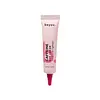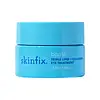What's inside
What's inside
 Key Ingredients
Key Ingredients

 Benefits
Benefits

 Concerns
Concerns

No concerns
 Ingredients Side-by-side
Ingredients Side-by-side

Water
Skin ConditioningGlycerin
HumectantCaprylic/Capric Triglyceride
MaskingDicaprylyl Ether
EmollientPolyglyceryl-3 Methylglucose Distearate
EmulsifyingNiacinamide
Smoothing1,2-Hexanediol
Skin ConditioningCetearyl Alcohol
EmollientDiisostearyl Malate
EmollientPentylene Glycol
Skin ConditioningAmmonium Acryloyldimethyltaurate/Vp Copolymer
Hydroxyethyl Acrylate/Sodium Acryloyldimethyl Taurate Copolymer
Emulsion StabilisingPanthenol
Skin ConditioningCaffeine
Skin ConditioningHydrogenated Lecithin
EmulsifyingEthylhexylglycerin
Skin ConditioningAdenosine
Skin ConditioningSorbitan Isostearate
EmulsifyingDisodium EDTA
Ceramide NP
Skin ConditioningSodium Hyaluronate
HumectantTocopherol
AntioxidantHydroxypropyltrimonium Hyaluronate
Hydrolyzed Hyaluronic Acid
HumectantSodium Acetylated Hyaluronate
HumectantHyaluronic Acid
HumectantHydrolyzed Sodium Hyaluronate
Skin ConditioningSodium Hyaluronate Crosspolymer
HumectantPotassium Hyaluronate
Skin ConditioningWater, Glycerin, Caprylic/Capric Triglyceride, Dicaprylyl Ether, Polyglyceryl-3 Methylglucose Distearate, Niacinamide, 1,2-Hexanediol, Cetearyl Alcohol, Diisostearyl Malate, Pentylene Glycol, Ammonium Acryloyldimethyltaurate/Vp Copolymer, Hydroxyethyl Acrylate/Sodium Acryloyldimethyl Taurate Copolymer, Panthenol, Caffeine, Hydrogenated Lecithin, Ethylhexylglycerin, Adenosine, Sorbitan Isostearate, Disodium EDTA, Ceramide NP, Sodium Hyaluronate, Tocopherol, Hydroxypropyltrimonium Hyaluronate, Hydrolyzed Hyaluronic Acid, Sodium Acetylated Hyaluronate, Hyaluronic Acid, Hydrolyzed Sodium Hyaluronate, Sodium Hyaluronate Crosspolymer, Potassium Hyaluronate
Water
Skin ConditioningCaprylyl Caprylate/Caprate
EmollientJojoba Oil/Macadamia Seed Oil Esters
Skin ConditioningPropanediol
SolventNiacinamide
SmoothingAmmonium Acryloyldimethyltaurate/Vp Copolymer
Hydroxyethyl Acrylate/Sodium Acryloyldimethyl Taurate Copolymer
Emulsion StabilisingCollagen Amino Acids
MoisturisingSqualane
EmollientCaffeine
Skin ConditioningSqualene
EmollientMacadamia Integrifolia Seed Oil
Skin ConditioningAsparagopsis Armata Extract
Skin ProtectingHydrogenated Starch Hydrolysate
HumectantPhytosteryl Macadamiate
Skin ConditioningAcetyl Glucosamine
Skin ConditioningAcetyl Glutamine
Skin ConditioningLecithin
EmollientPhospholipids
Skin ConditioningLeuconostoc/Radish Root Ferment Filtrate
AntimicrobialPolyglutamic Acid
Skin ConditioningPhytosterols
Skin ConditioningAscophyllum Nodosum Extract
Skin ConditioningCeramide NP
Skin ConditioningBacillus/Soybean Ferment Extract
Skin ConditioningOligopeptide-3
Skin ConditioningOligopeptide-2
Skin ConditioningOligopeptide-1
Skin ConditioningHexapeptide-11
Skin ConditioningTocopheryl Acetate
AntioxidantSodium Hyaluronate
HumectantFolic Acid
Skin ConditioningAmylopectin
Tocopherol
AntioxidantPhytosphingosine
Skin ConditioningCeramide AP
Skin ConditioningCholesterol
EmollientLithothamnion Calcareum Extract
Skin ConditioningLactic Acid
BufferingMyrica Cerifera Fruit Extract
HumectantHydroxyacetophenone
AntioxidantPrunus Lannesiana Flower Extract
Skin ConditioningAkebia Quinata Stem Extract
Skin ConditioningSaccharomyces Lysate
Skin ConditioningLactobacillus Ferment Lysate
Skin ConditioningCeramide EOP
Skin ConditioningTripeptide-1
Skin ConditioningCaprylyl Glycol
EmollientPolysorbate 60
EmulsifyingGlycerin
HumectantEthylhexylglycerin
Skin ConditioningHexylene Glycol
EmulsifyingSodium Lauroyl Lactylate
EmulsifyingSorbitan Isostearate
EmulsifyingTrisodium Ethylenediamine Disuccinate
Butylene Glycol
HumectantPentylene Glycol
Skin ConditioningXanthan Gum
EmulsifyingCarbomer
Emulsion StabilisingSodium Benzoate
MaskingPotassium Sorbate
Preservative1,2-Hexanediol
Skin ConditioningDextran
Phenoxyethanol
PreservativeWater, Caprylyl Caprylate/Caprate, Jojoba Oil/Macadamia Seed Oil Esters, Propanediol, Niacinamide, Ammonium Acryloyldimethyltaurate/Vp Copolymer, Hydroxyethyl Acrylate/Sodium Acryloyldimethyl Taurate Copolymer, Collagen Amino Acids, Squalane, Caffeine, Squalene, Macadamia Integrifolia Seed Oil, Asparagopsis Armata Extract, Hydrogenated Starch Hydrolysate, Phytosteryl Macadamiate, Acetyl Glucosamine, Acetyl Glutamine, Lecithin, Phospholipids, Leuconostoc/Radish Root Ferment Filtrate, Polyglutamic Acid, Phytosterols, Ascophyllum Nodosum Extract, Ceramide NP, Bacillus/Soybean Ferment Extract, Oligopeptide-3, Oligopeptide-2, Oligopeptide-1, Hexapeptide-11, Tocopheryl Acetate, Sodium Hyaluronate, Folic Acid, Amylopectin, Tocopherol, Phytosphingosine, Ceramide AP, Cholesterol, Lithothamnion Calcareum Extract, Lactic Acid, Myrica Cerifera Fruit Extract, Hydroxyacetophenone, Prunus Lannesiana Flower Extract, Akebia Quinata Stem Extract, Saccharomyces Lysate, Lactobacillus Ferment Lysate, Ceramide EOP, Tripeptide-1, Caprylyl Glycol, Polysorbate 60, Glycerin, Ethylhexylglycerin, Hexylene Glycol, Sodium Lauroyl Lactylate, Sorbitan Isostearate, Trisodium Ethylenediamine Disuccinate, Butylene Glycol, Pentylene Glycol, Xanthan Gum, Carbomer, Sodium Benzoate, Potassium Sorbate, 1,2-Hexanediol, Dextran, Phenoxyethanol
Ingredients Explained
These ingredients are found in both products.
Ingredients higher up in an ingredient list are typically present in a larger amount.
1,2-Hexanediol is a synthetic liquid and another multi-functional powerhouse.
It is a:
- Humectant, drawing moisture into the skin
- Emollient, helping to soften skin
- Solvent, dispersing and stabilizing formulas
- Preservative booster, enhancing the antimicrobial activity of other preservatives
Ammonium Acryloyldimethyltaurate/Vp Copolymer (let's call it AAVC for short) is a synthetically created polymer. It's used as a film-forming agent and used to thicken the consistency of products.
AAVC is able to increase the consistency and viscosity of products due to its large molecule size. It also prevents ingredients from separating.
Caffeine is most associated with coffee, tea, and cacao. In skincare, it helps with calming inflammation and is rich in antioxidants.
While caffeine is used to treat cellulite and and dark circles, further studies are needed to prove this. It has been believed to help with these skin conditions due to its ability to dilate blood vessels and increase blood flow.
Some studies are looking into caffeine's ability to protect against UV rays.
Learn more about CaffeineCeramide NP is a type of ceramide and formally known as ceramide 3.
Ceramides are intercellular lipids naturally found in our skin that bonds dead skin cells together to create a barrier. They are known for their ability to hold water and thus are a great ingredient for dry skin.
Ceramides are an important building block for our skin barrier. A stronger barrier helps the skin look more firm and hydrated. By bolstering the skin ceramides act as a barrier against irritating ingredients. This can help with inflammation as well.
If you would like to eat ceramides, sweet potatoes contain a small amount.
Read more about other common types of ceramides here:
Ceramide AP
Ceramide EOP
Ethylhexylglycerin (we can't pronounce this either) is commonly used as a preservative and skin softener. It is derived from glyceryl.
You might see Ethylhexylglycerin often paired with other preservatives such as phenoxyethanol. Ethylhexylglycerin has been found to increase the effectiveness of these other preservatives.
Glycerin is already naturally found in your skin. It helps moisturize and protect your skin.
A study from 2016 found glycerin to be more effective as a humectant than AHAs and hyaluronic acid.
As a humectant, it helps the skin stay hydrated by pulling moisture to your skin. The low molecular weight of glycerin allows it to pull moisture into the deeper layers of your skin.
Hydrated skin improves your skin barrier; Your skin barrier helps protect against irritants and bacteria.
Glycerin has also been found to have antimicrobial and antiviral properties. Due to these properties, glycerin is often used in wound and burn treatments.
In cosmetics, glycerin is usually derived from plants such as soybean or palm. However, it can also be sourced from animals, such as tallow or animal fat.
This ingredient is organic, colorless, odorless, and non-toxic.
Glycerin is the name for this ingredient in American English. British English uses Glycerol/Glycerine.
Learn more about GlycerinThis is a synthetic polymer. It helps improve the texture of products by adding thickness and gel-like feel.
It is also an emulsifer, meaning it prevents ingredients such as oil and water from separating. It also helps evenly disperse other ingredients.
Niacinamide is a multitasking form of vitamin B3 that strengthens the skin barrier, reduces pores and dark spots, regulates oil, and improves signs of aging.
And the best part? It's gentle and well-tolerated by most skin types, including sensitive and reactive skin.
You might have heard of "niacin flush", or the reddening of skin that causes itchiness. Niacinamide has not been found to cause this.
In very rare cases, some individuals may not be able to tolerate niacinamide at all or experience an allergic reaction to it.
If you are experiencing flaking, irritation, and dryness with this ingredient, be sure to double check all your products as this ingredient can be found in all categories of skincare.
When incorporating niacinamide into your routine, look out for concentration amounts. Typically, 5% niacinamide provides benefits such as fading dark spots. However, if you have sensitive skin, it is better to begin with a smaller concentration.
When you apply niacinamide to your skin, your body converts it into nicotinamide adenine dinucleotide (NAD). NAD is an essential coenzyme that is already found in your cells as "fuel" and powers countless biological processes.
In your skin, NAD helps repair cell damage, produce new healthy cells, support collagen production, strengthen the skin barrier, and fight environmental stressors (like UV and pollution).
Our natural NAD levels start to decline with age, leading to slower skin repair, visible aging, and a weaker skin barrier. By providing your skin niacinamide, you're recharging your skin's NAD levels. This leads to stronger, healthier, and younger looking skin.
Another name for vitamin B3 is nicotinamide. This vitamin is water-soluble and our bodies don't store it. We obtain Vitamin B3 from either food or skincare. Meat, fish, wheat, yeast, and leafy greens contain vitamin B3.
The type of niacinamide used in skincare is synthetically created.
Learn more about NiacinamidePentylene glycol is typically used within a product to thicken it. It also adds a smooth, soft, and moisturizing feel to the product. It is naturally found in plants such as sugar beets.
The hydrophilic trait of Pentylene Glycol makes it a humectant. As a humectant, Pentylene Glycol helps draw moisture from the air to your skin. This can help keep your skin hydrated.
This property also makes Pentylene Glycol a great texture enhancer. It can also help thicken or stabilize a product.
Pentylene Glycol also acts as a mild preservative and helps to keep a product microbe-free.
Some people may experience mild eye and skin irritation from Pentylene Glycol. We always recommend speaking with a professional about using this ingredient in your routine.
Pentylene Glycol has a low molecular weight and is part of the 1,2-glycol family.
Learn more about Pentylene GlycolSodium Hyaluronate is hyaluronic acid's salt form. It is commonly derived from the sodium salt of hyaluronic acid.
Like hyaluronic acid, it is great at holding water and acts as a humectant. This makes it a great skin hydrating ingredient.
Sodium Hyaluronate is naturally occurring in our bodies and is mostly found in eye fluid and joints.
These are some other common types of Hyaluronic Acid:
Learn more about Sodium HyaluronateSorbitan Isostearate is an emulsifer and cleaning agent. It is created from isostearic acid and sorbitol.
As an emulsifier, Sorbitan Isostearate prevents oils and water from separating.
Due to its isostearic acid base, it may not be safe for Malassezia or fungal acne.
Learn more about Sorbitan IsostearateTocopherol (also known as Vitamin E) is a common antioxidant used to help protect the skin from free-radicals and strengthen the skin barrier. It's also fat soluble - this means our skin is great at absorbing it.
Vitamin E also helps keep your natural skin lipids healthy. Your lipid skin barrier naturally consists of lipids, ceramides, and fatty acids. Vitamin E offers extra protection for your skin’s lipid barrier, keeping your skin healthy and nourished.
Another benefit is a bit of UV protection. Vitamin E helps reduce the damage caused by UVB rays. (It should not replace your sunscreen). Combining it with Vitamin C can decrease sunburned cells and hyperpigmentation after UV exposure.
You might have noticed Vitamin E + C often paired together. This is because it is great at stabilizing Vitamin C. Using the two together helps increase the effectiveness of both ingredients.
There are often claims that Vitamin E can reduce/prevent scarring, but these claims haven't been confirmed by scientific research.
Learn more about TocopherolWater. It's the most common cosmetic ingredient of all. You'll usually see it at the top of ingredient lists, meaning that it makes up the largest part of the product.
So why is it so popular? Water most often acts as a solvent - this means that it helps dissolve other ingredients into the formulation.
You'll also recognize water as that liquid we all need to stay alive. If you see this, drink a glass of water. Stay hydrated!
Learn more about Water